Pharmacological Studies: Understanding Chemical Risk Assessment and Toxicity Testing
VerifiedAdded on 2023/06/12
|14
|4078
|400
AI Summary
This article discusses the importance of chemical risk assessment and toxicity testing in pharmacological studies. It covers in vitro and in vivo testing, genotoxicity, and neurotoxicity. The concept of Acceptable Daily Intake (ADI) and Trans-generational toxicity are also explored.
Contribute Materials
Your contribution can guide someone’s learning journey. Share your
documents today.
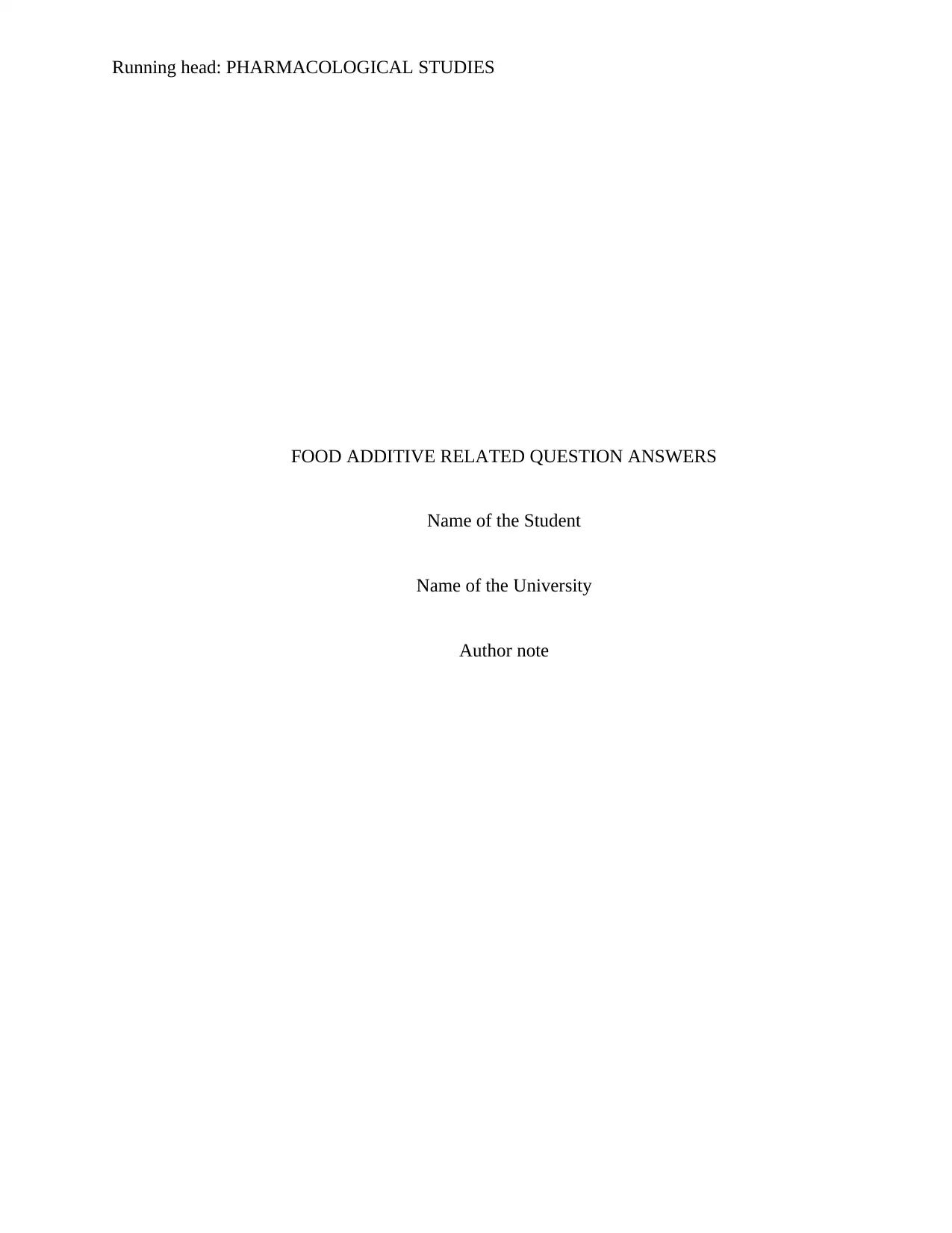
Running head: PHARMACOLOGICAL STUDIES
FOOD ADDITIVE RELATED QUESTION ANSWERS
Name of the Student
Name of the University
Author note
FOOD ADDITIVE RELATED QUESTION ANSWERS
Name of the Student
Name of the University
Author note
Secure Best Marks with AI Grader
Need help grading? Try our AI Grader for instant feedback on your assignments.
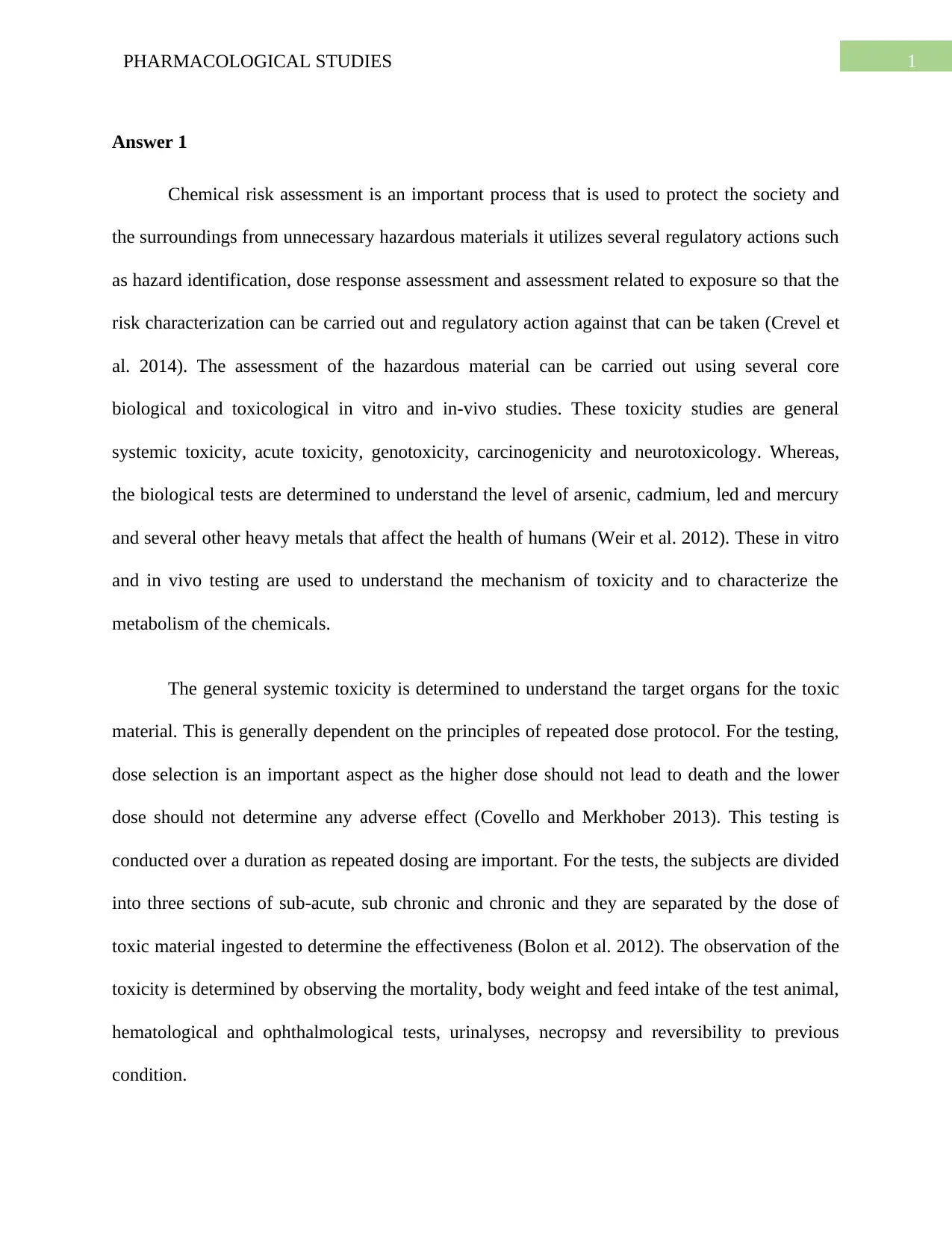
1PHARMACOLOGICAL STUDIES
Answer 1
Chemical risk assessment is an important process that is used to protect the society and
the surroundings from unnecessary hazardous materials it utilizes several regulatory actions such
as hazard identification, dose response assessment and assessment related to exposure so that the
risk characterization can be carried out and regulatory action against that can be taken (Crevel et
al. 2014). The assessment of the hazardous material can be carried out using several core
biological and toxicological in vitro and in-vivo studies. These toxicity studies are general
systemic toxicity, acute toxicity, genotoxicity, carcinogenicity and neurotoxicology. Whereas,
the biological tests are determined to understand the level of arsenic, cadmium, led and mercury
and several other heavy metals that affect the health of humans (Weir et al. 2012). These in vitro
and in vivo testing are used to understand the mechanism of toxicity and to characterize the
metabolism of the chemicals.
The general systemic toxicity is determined to understand the target organs for the toxic
material. This is generally dependent on the principles of repeated dose protocol. For the testing,
dose selection is an important aspect as the higher dose should not lead to death and the lower
dose should not determine any adverse effect (Covello and Merkhober 2013). This testing is
conducted over a duration as repeated dosing are important. For the tests, the subjects are divided
into three sections of sub-acute, sub chronic and chronic and they are separated by the dose of
toxic material ingested to determine the effectiveness (Bolon et al. 2012). The observation of the
toxicity is determined by observing the mortality, body weight and feed intake of the test animal,
hematological and ophthalmological tests, urinalyses, necropsy and reversibility to previous
condition.
Answer 1
Chemical risk assessment is an important process that is used to protect the society and
the surroundings from unnecessary hazardous materials it utilizes several regulatory actions such
as hazard identification, dose response assessment and assessment related to exposure so that the
risk characterization can be carried out and regulatory action against that can be taken (Crevel et
al. 2014). The assessment of the hazardous material can be carried out using several core
biological and toxicological in vitro and in-vivo studies. These toxicity studies are general
systemic toxicity, acute toxicity, genotoxicity, carcinogenicity and neurotoxicology. Whereas,
the biological tests are determined to understand the level of arsenic, cadmium, led and mercury
and several other heavy metals that affect the health of humans (Weir et al. 2012). These in vitro
and in vivo testing are used to understand the mechanism of toxicity and to characterize the
metabolism of the chemicals.
The general systemic toxicity is determined to understand the target organs for the toxic
material. This is generally dependent on the principles of repeated dose protocol. For the testing,
dose selection is an important aspect as the higher dose should not lead to death and the lower
dose should not determine any adverse effect (Covello and Merkhober 2013). This testing is
conducted over a duration as repeated dosing are important. For the tests, the subjects are divided
into three sections of sub-acute, sub chronic and chronic and they are separated by the dose of
toxic material ingested to determine the effectiveness (Bolon et al. 2012). The observation of the
toxicity is determined by observing the mortality, body weight and feed intake of the test animal,
hematological and ophthalmological tests, urinalyses, necropsy and reversibility to previous
condition.
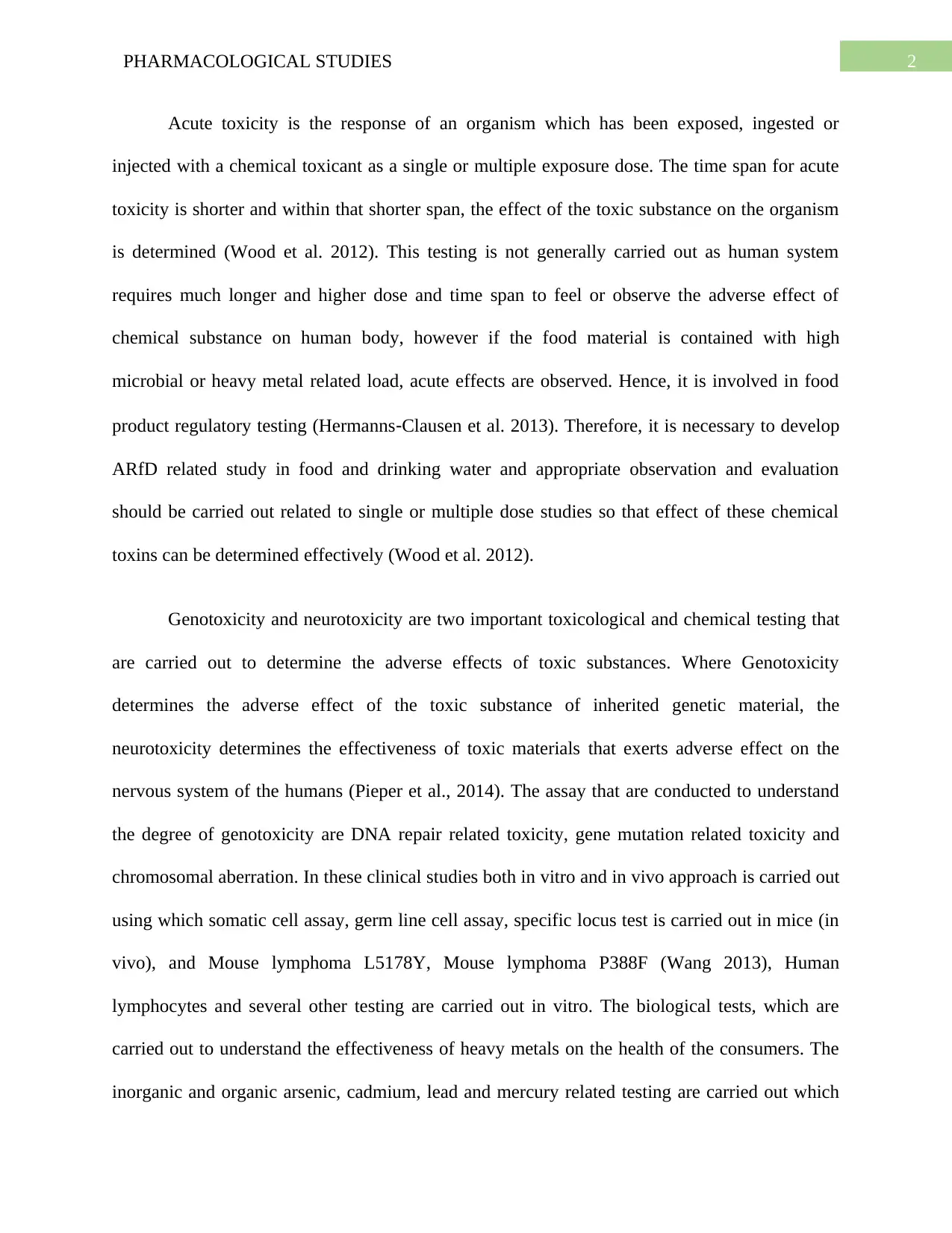
2PHARMACOLOGICAL STUDIES
Acute toxicity is the response of an organism which has been exposed, ingested or
injected with a chemical toxicant as a single or multiple exposure dose. The time span for acute
toxicity is shorter and within that shorter span, the effect of the toxic substance on the organism
is determined (Wood et al. 2012). This testing is not generally carried out as human system
requires much longer and higher dose and time span to feel or observe the adverse effect of
chemical substance on human body, however if the food material is contained with high
microbial or heavy metal related load, acute effects are observed. Hence, it is involved in food
product regulatory testing (Hermanns‐Clausen et al. 2013). Therefore, it is necessary to develop
ARfD related study in food and drinking water and appropriate observation and evaluation
should be carried out related to single or multiple dose studies so that effect of these chemical
toxins can be determined effectively (Wood et al. 2012).
Genotoxicity and neurotoxicity are two important toxicological and chemical testing that
are carried out to determine the adverse effects of toxic substances. Where Genotoxicity
determines the adverse effect of the toxic substance of inherited genetic material, the
neurotoxicity determines the effectiveness of toxic materials that exerts adverse effect on the
nervous system of the humans (Pieper et al., 2014). The assay that are conducted to understand
the degree of genotoxicity are DNA repair related toxicity, gene mutation related toxicity and
chromosomal aberration. In these clinical studies both in vitro and in vivo approach is carried out
using which somatic cell assay, germ line cell assay, specific locus test is carried out in mice (in
vivo), and Mouse lymphoma L5178Y, Mouse lymphoma P388F (Wang 2013), Human
lymphocytes and several other testing are carried out in vitro. The biological tests, which are
carried out to understand the effectiveness of heavy metals on the health of the consumers. The
inorganic and organic arsenic, cadmium, lead and mercury related testing are carried out which
Acute toxicity is the response of an organism which has been exposed, ingested or
injected with a chemical toxicant as a single or multiple exposure dose. The time span for acute
toxicity is shorter and within that shorter span, the effect of the toxic substance on the organism
is determined (Wood et al. 2012). This testing is not generally carried out as human system
requires much longer and higher dose and time span to feel or observe the adverse effect of
chemical substance on human body, however if the food material is contained with high
microbial or heavy metal related load, acute effects are observed. Hence, it is involved in food
product regulatory testing (Hermanns‐Clausen et al. 2013). Therefore, it is necessary to develop
ARfD related study in food and drinking water and appropriate observation and evaluation
should be carried out related to single or multiple dose studies so that effect of these chemical
toxins can be determined effectively (Wood et al. 2012).
Genotoxicity and neurotoxicity are two important toxicological and chemical testing that
are carried out to determine the adverse effects of toxic substances. Where Genotoxicity
determines the adverse effect of the toxic substance of inherited genetic material, the
neurotoxicity determines the effectiveness of toxic materials that exerts adverse effect on the
nervous system of the humans (Pieper et al., 2014). The assay that are conducted to understand
the degree of genotoxicity are DNA repair related toxicity, gene mutation related toxicity and
chromosomal aberration. In these clinical studies both in vitro and in vivo approach is carried out
using which somatic cell assay, germ line cell assay, specific locus test is carried out in mice (in
vivo), and Mouse lymphoma L5178Y, Mouse lymphoma P388F (Wang 2013), Human
lymphocytes and several other testing are carried out in vitro. The biological tests, which are
carried out to understand the effectiveness of heavy metals on the health of the consumers. The
inorganic and organic arsenic, cadmium, lead and mercury related testing are carried out which
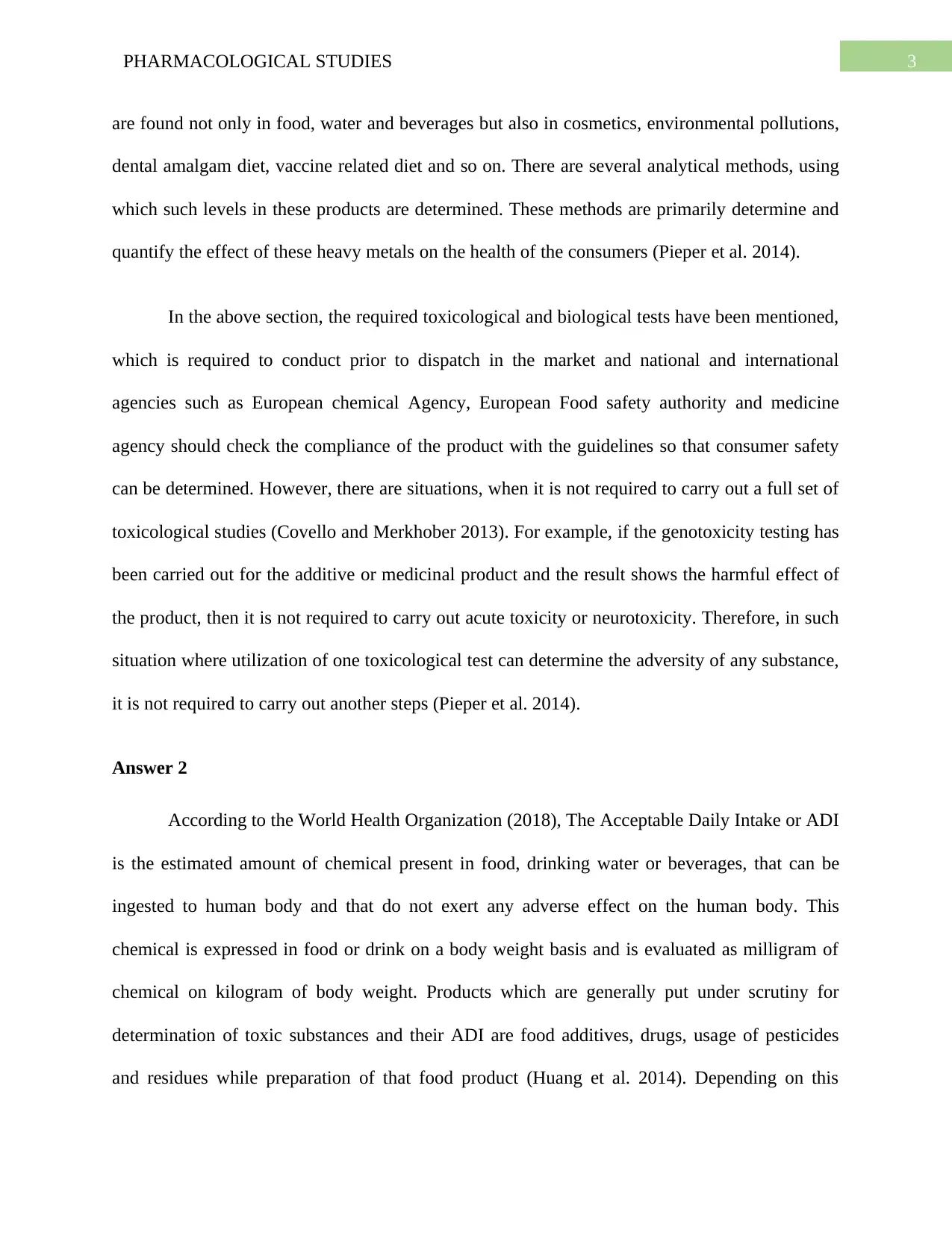
3PHARMACOLOGICAL STUDIES
are found not only in food, water and beverages but also in cosmetics, environmental pollutions,
dental amalgam diet, vaccine related diet and so on. There are several analytical methods, using
which such levels in these products are determined. These methods are primarily determine and
quantify the effect of these heavy metals on the health of the consumers (Pieper et al. 2014).
In the above section, the required toxicological and biological tests have been mentioned,
which is required to conduct prior to dispatch in the market and national and international
agencies such as European chemical Agency, European Food safety authority and medicine
agency should check the compliance of the product with the guidelines so that consumer safety
can be determined. However, there are situations, when it is not required to carry out a full set of
toxicological studies (Covello and Merkhober 2013). For example, if the genotoxicity testing has
been carried out for the additive or medicinal product and the result shows the harmful effect of
the product, then it is not required to carry out acute toxicity or neurotoxicity. Therefore, in such
situation where utilization of one toxicological test can determine the adversity of any substance,
it is not required to carry out another steps (Pieper et al. 2014).
Answer 2
According to the World Health Organization (2018), The Acceptable Daily Intake or ADI
is the estimated amount of chemical present in food, drinking water or beverages, that can be
ingested to human body and that do not exert any adverse effect on the human body. This
chemical is expressed in food or drink on a body weight basis and is evaluated as milligram of
chemical on kilogram of body weight. Products which are generally put under scrutiny for
determination of toxic substances and their ADI are food additives, drugs, usage of pesticides
and residues while preparation of that food product (Huang et al. 2014). Depending on this
are found not only in food, water and beverages but also in cosmetics, environmental pollutions,
dental amalgam diet, vaccine related diet and so on. There are several analytical methods, using
which such levels in these products are determined. These methods are primarily determine and
quantify the effect of these heavy metals on the health of the consumers (Pieper et al. 2014).
In the above section, the required toxicological and biological tests have been mentioned,
which is required to conduct prior to dispatch in the market and national and international
agencies such as European chemical Agency, European Food safety authority and medicine
agency should check the compliance of the product with the guidelines so that consumer safety
can be determined. However, there are situations, when it is not required to carry out a full set of
toxicological studies (Covello and Merkhober 2013). For example, if the genotoxicity testing has
been carried out for the additive or medicinal product and the result shows the harmful effect of
the product, then it is not required to carry out acute toxicity or neurotoxicity. Therefore, in such
situation where utilization of one toxicological test can determine the adversity of any substance,
it is not required to carry out another steps (Pieper et al. 2014).
Answer 2
According to the World Health Organization (2018), The Acceptable Daily Intake or ADI
is the estimated amount of chemical present in food, drinking water or beverages, that can be
ingested to human body and that do not exert any adverse effect on the human body. This
chemical is expressed in food or drink on a body weight basis and is evaluated as milligram of
chemical on kilogram of body weight. Products which are generally put under scrutiny for
determination of toxic substances and their ADI are food additives, drugs, usage of pesticides
and residues while preparation of that food product (Huang et al. 2014). Depending on this
Secure Best Marks with AI Grader
Need help grading? Try our AI Grader for instant feedback on your assignments.
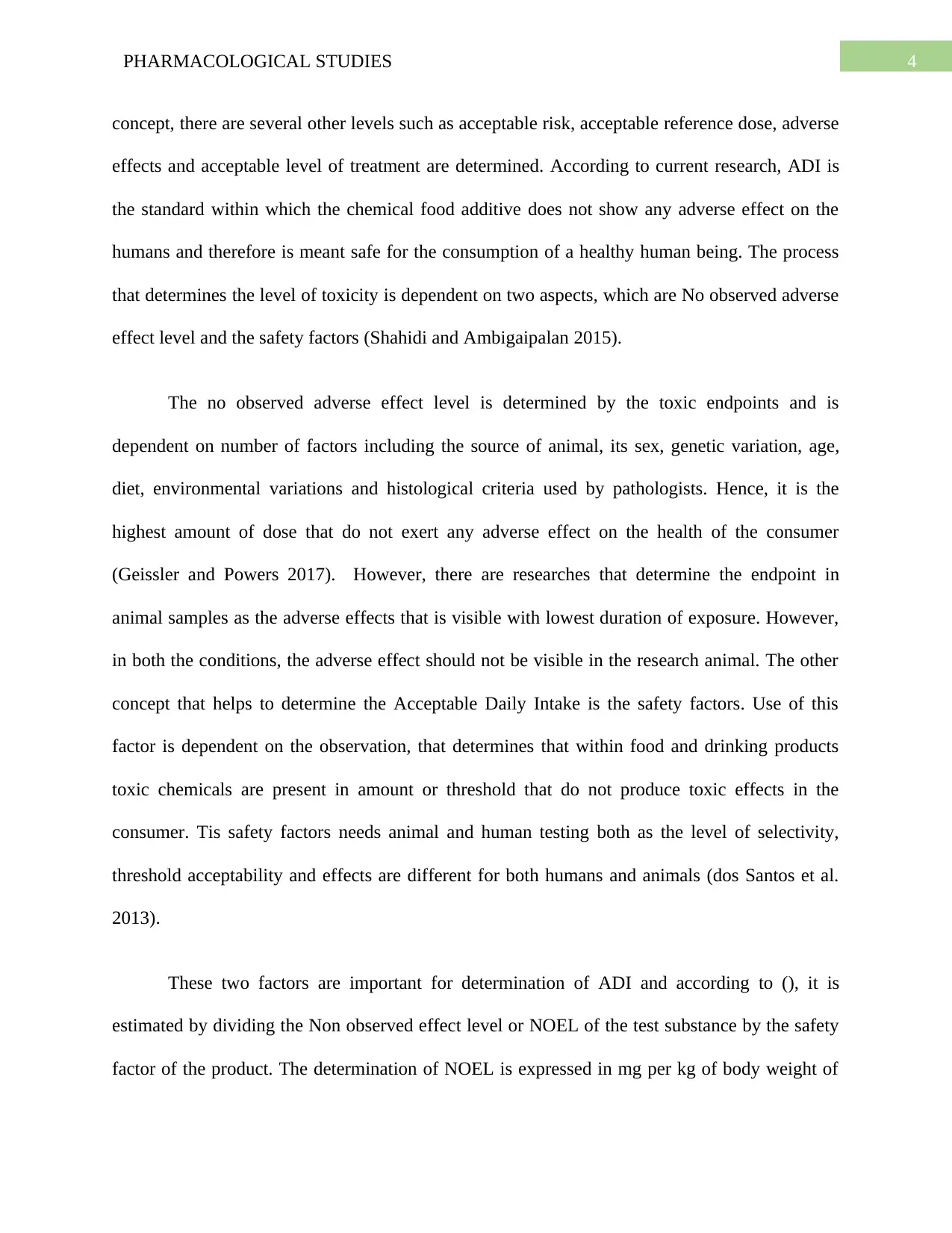
4PHARMACOLOGICAL STUDIES
concept, there are several other levels such as acceptable risk, acceptable reference dose, adverse
effects and acceptable level of treatment are determined. According to current research, ADI is
the standard within which the chemical food additive does not show any adverse effect on the
humans and therefore is meant safe for the consumption of a healthy human being. The process
that determines the level of toxicity is dependent on two aspects, which are No observed adverse
effect level and the safety factors (Shahidi and Ambigaipalan 2015).
The no observed adverse effect level is determined by the toxic endpoints and is
dependent on number of factors including the source of animal, its sex, genetic variation, age,
diet, environmental variations and histological criteria used by pathologists. Hence, it is the
highest amount of dose that do not exert any adverse effect on the health of the consumer
(Geissler and Powers 2017). However, there are researches that determine the endpoint in
animal samples as the adverse effects that is visible with lowest duration of exposure. However,
in both the conditions, the adverse effect should not be visible in the research animal. The other
concept that helps to determine the Acceptable Daily Intake is the safety factors. Use of this
factor is dependent on the observation, that determines that within food and drinking products
toxic chemicals are present in amount or threshold that do not produce toxic effects in the
consumer. Tis safety factors needs animal and human testing both as the level of selectivity,
threshold acceptability and effects are different for both humans and animals (dos Santos et al.
2013).
These two factors are important for determination of ADI and according to (), it is
estimated by dividing the Non observed effect level or NOEL of the test substance by the safety
factor of the product. The determination of NOEL is expressed in mg per kg of body weight of
concept, there are several other levels such as acceptable risk, acceptable reference dose, adverse
effects and acceptable level of treatment are determined. According to current research, ADI is
the standard within which the chemical food additive does not show any adverse effect on the
humans and therefore is meant safe for the consumption of a healthy human being. The process
that determines the level of toxicity is dependent on two aspects, which are No observed adverse
effect level and the safety factors (Shahidi and Ambigaipalan 2015).
The no observed adverse effect level is determined by the toxic endpoints and is
dependent on number of factors including the source of animal, its sex, genetic variation, age,
diet, environmental variations and histological criteria used by pathologists. Hence, it is the
highest amount of dose that do not exert any adverse effect on the health of the consumer
(Geissler and Powers 2017). However, there are researches that determine the endpoint in
animal samples as the adverse effects that is visible with lowest duration of exposure. However,
in both the conditions, the adverse effect should not be visible in the research animal. The other
concept that helps to determine the Acceptable Daily Intake is the safety factors. Use of this
factor is dependent on the observation, that determines that within food and drinking products
toxic chemicals are present in amount or threshold that do not produce toxic effects in the
consumer. Tis safety factors needs animal and human testing both as the level of selectivity,
threshold acceptability and effects are different for both humans and animals (dos Santos et al.
2013).
These two factors are important for determination of ADI and according to (), it is
estimated by dividing the Non observed effect level or NOEL of the test substance by the safety
factor of the product. The determination of NOEL is expressed in mg per kg of body weight of
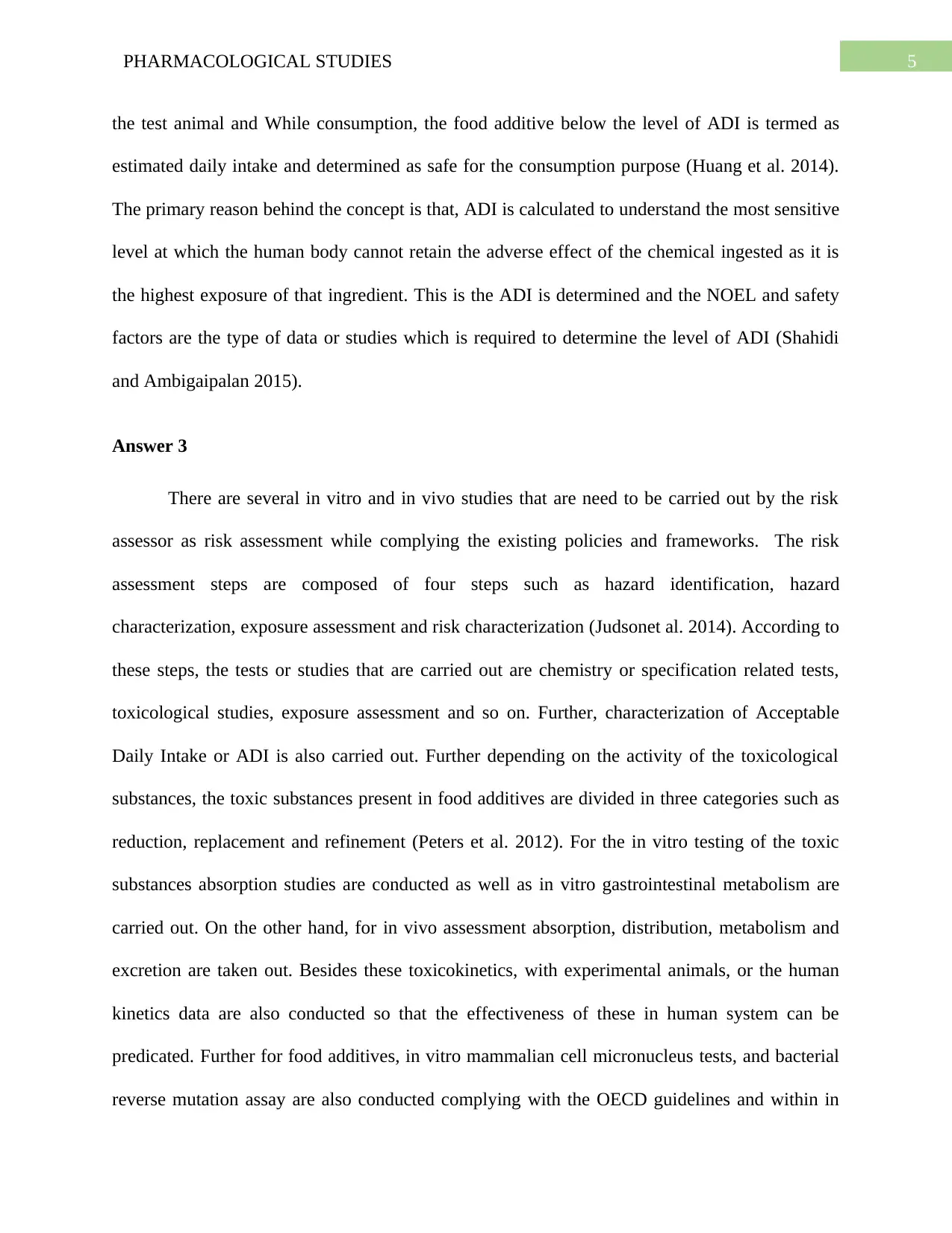
5PHARMACOLOGICAL STUDIES
the test animal and While consumption, the food additive below the level of ADI is termed as
estimated daily intake and determined as safe for the consumption purpose (Huang et al. 2014).
The primary reason behind the concept is that, ADI is calculated to understand the most sensitive
level at which the human body cannot retain the adverse effect of the chemical ingested as it is
the highest exposure of that ingredient. This is the ADI is determined and the NOEL and safety
factors are the type of data or studies which is required to determine the level of ADI (Shahidi
and Ambigaipalan 2015).
Answer 3
There are several in vitro and in vivo studies that are need to be carried out by the risk
assessor as risk assessment while complying the existing policies and frameworks. The risk
assessment steps are composed of four steps such as hazard identification, hazard
characterization, exposure assessment and risk characterization (Judsonet al. 2014). According to
these steps, the tests or studies that are carried out are chemistry or specification related tests,
toxicological studies, exposure assessment and so on. Further, characterization of Acceptable
Daily Intake or ADI is also carried out. Further depending on the activity of the toxicological
substances, the toxic substances present in food additives are divided in three categories such as
reduction, replacement and refinement (Peters et al. 2012). For the in vitro testing of the toxic
substances absorption studies are conducted as well as in vitro gastrointestinal metabolism are
carried out. On the other hand, for in vivo assessment absorption, distribution, metabolism and
excretion are taken out. Besides these toxicokinetics, with experimental animals, or the human
kinetics data are also conducted so that the effectiveness of these in human system can be
predicated. Further for food additives, in vitro mammalian cell micronucleus tests, and bacterial
reverse mutation assay are also conducted complying with the OECD guidelines and within in
the test animal and While consumption, the food additive below the level of ADI is termed as
estimated daily intake and determined as safe for the consumption purpose (Huang et al. 2014).
The primary reason behind the concept is that, ADI is calculated to understand the most sensitive
level at which the human body cannot retain the adverse effect of the chemical ingested as it is
the highest exposure of that ingredient. This is the ADI is determined and the NOEL and safety
factors are the type of data or studies which is required to determine the level of ADI (Shahidi
and Ambigaipalan 2015).
Answer 3
There are several in vitro and in vivo studies that are need to be carried out by the risk
assessor as risk assessment while complying the existing policies and frameworks. The risk
assessment steps are composed of four steps such as hazard identification, hazard
characterization, exposure assessment and risk characterization (Judsonet al. 2014). According to
these steps, the tests or studies that are carried out are chemistry or specification related tests,
toxicological studies, exposure assessment and so on. Further, characterization of Acceptable
Daily Intake or ADI is also carried out. Further depending on the activity of the toxicological
substances, the toxic substances present in food additives are divided in three categories such as
reduction, replacement and refinement (Peters et al. 2012). For the in vitro testing of the toxic
substances absorption studies are conducted as well as in vitro gastrointestinal metabolism are
carried out. On the other hand, for in vivo assessment absorption, distribution, metabolism and
excretion are taken out. Besides these toxicokinetics, with experimental animals, or the human
kinetics data are also conducted so that the effectiveness of these in human system can be
predicated. Further for food additives, in vitro mammalian cell micronucleus tests, and bacterial
reverse mutation assay are also conducted complying with the OECD guidelines and within in
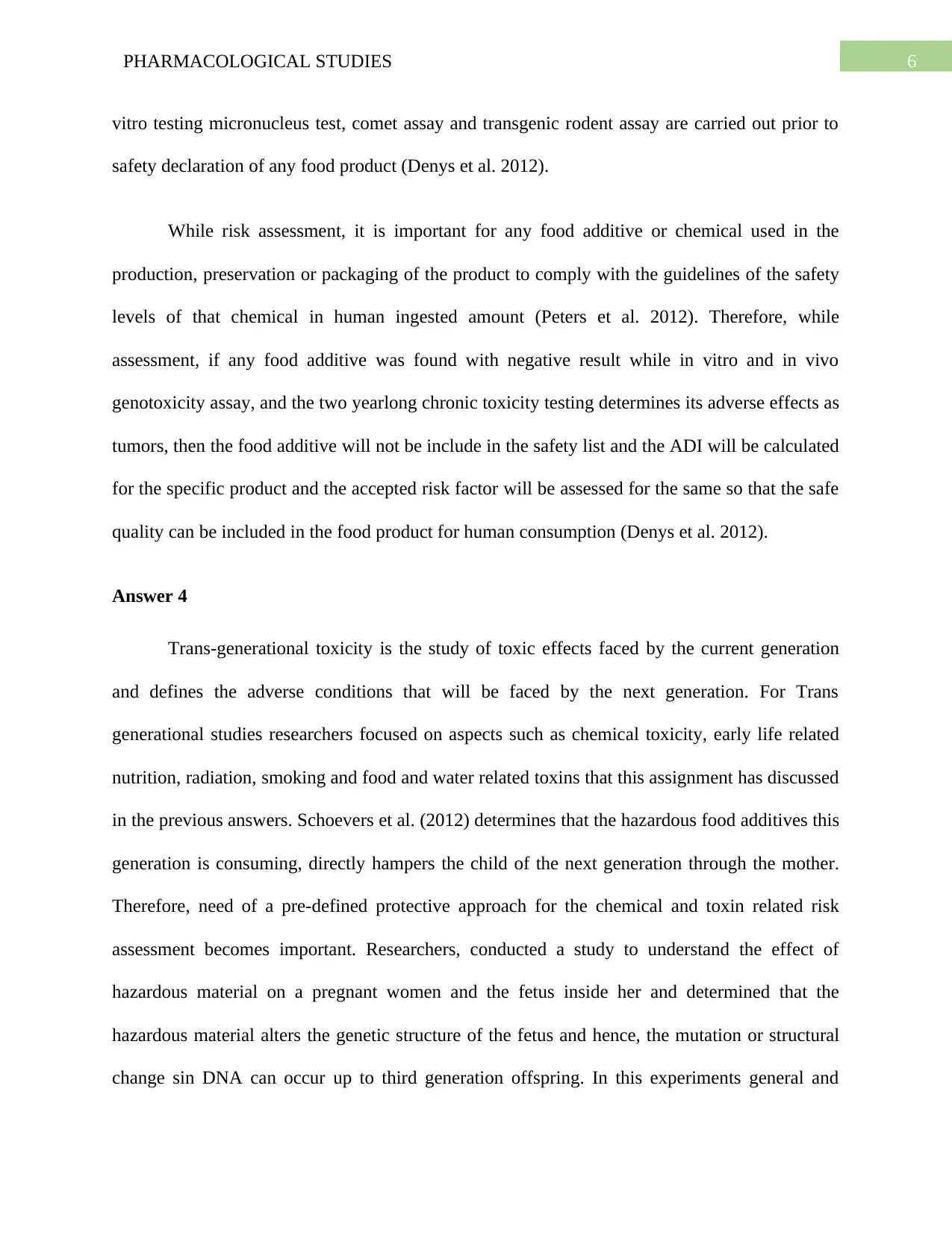
6PHARMACOLOGICAL STUDIES
vitro testing micronucleus test, comet assay and transgenic rodent assay are carried out prior to
safety declaration of any food product (Denys et al. 2012).
While risk assessment, it is important for any food additive or chemical used in the
production, preservation or packaging of the product to comply with the guidelines of the safety
levels of that chemical in human ingested amount (Peters et al. 2012). Therefore, while
assessment, if any food additive was found with negative result while in vitro and in vivo
genotoxicity assay, and the two yearlong chronic toxicity testing determines its adverse effects as
tumors, then the food additive will not be include in the safety list and the ADI will be calculated
for the specific product and the accepted risk factor will be assessed for the same so that the safe
quality can be included in the food product for human consumption (Denys et al. 2012).
Answer 4
Trans-generational toxicity is the study of toxic effects faced by the current generation
and defines the adverse conditions that will be faced by the next generation. For Trans
generational studies researchers focused on aspects such as chemical toxicity, early life related
nutrition, radiation, smoking and food and water related toxins that this assignment has discussed
in the previous answers. Schoevers et al. (2012) determines that the hazardous food additives this
generation is consuming, directly hampers the child of the next generation through the mother.
Therefore, need of a pre-defined protective approach for the chemical and toxin related risk
assessment becomes important. Researchers, conducted a study to understand the effect of
hazardous material on a pregnant women and the fetus inside her and determined that the
hazardous material alters the genetic structure of the fetus and hence, the mutation or structural
change sin DNA can occur up to third generation offspring. In this experiments general and
vitro testing micronucleus test, comet assay and transgenic rodent assay are carried out prior to
safety declaration of any food product (Denys et al. 2012).
While risk assessment, it is important for any food additive or chemical used in the
production, preservation or packaging of the product to comply with the guidelines of the safety
levels of that chemical in human ingested amount (Peters et al. 2012). Therefore, while
assessment, if any food additive was found with negative result while in vitro and in vivo
genotoxicity assay, and the two yearlong chronic toxicity testing determines its adverse effects as
tumors, then the food additive will not be include in the safety list and the ADI will be calculated
for the specific product and the accepted risk factor will be assessed for the same so that the safe
quality can be included in the food product for human consumption (Denys et al. 2012).
Answer 4
Trans-generational toxicity is the study of toxic effects faced by the current generation
and defines the adverse conditions that will be faced by the next generation. For Trans
generational studies researchers focused on aspects such as chemical toxicity, early life related
nutrition, radiation, smoking and food and water related toxins that this assignment has discussed
in the previous answers. Schoevers et al. (2012) determines that the hazardous food additives this
generation is consuming, directly hampers the child of the next generation through the mother.
Therefore, need of a pre-defined protective approach for the chemical and toxin related risk
assessment becomes important. Researchers, conducted a study to understand the effect of
hazardous material on a pregnant women and the fetus inside her and determined that the
hazardous material alters the genetic structure of the fetus and hence, the mutation or structural
change sin DNA can occur up to third generation offspring. In this experiments general and
Paraphrase This Document
Need a fresh take? Get an instant paraphrase of this document with our AI Paraphraser
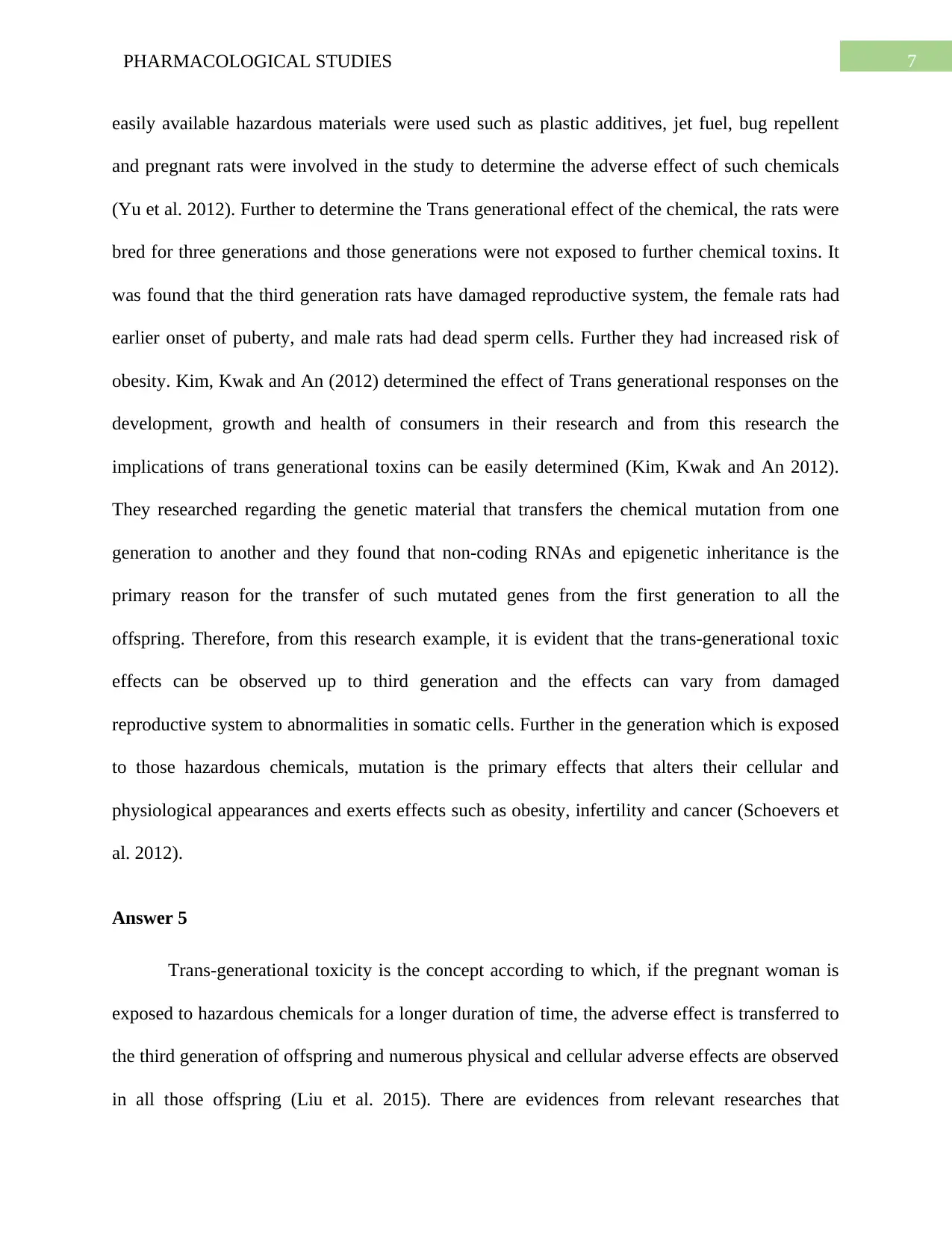
7PHARMACOLOGICAL STUDIES
easily available hazardous materials were used such as plastic additives, jet fuel, bug repellent
and pregnant rats were involved in the study to determine the adverse effect of such chemicals
(Yu et al. 2012). Further to determine the Trans generational effect of the chemical, the rats were
bred for three generations and those generations were not exposed to further chemical toxins. It
was found that the third generation rats have damaged reproductive system, the female rats had
earlier onset of puberty, and male rats had dead sperm cells. Further they had increased risk of
obesity. Kim, Kwak and An (2012) determined the effect of Trans generational responses on the
development, growth and health of consumers in their research and from this research the
implications of trans generational toxins can be easily determined (Kim, Kwak and An 2012).
They researched regarding the genetic material that transfers the chemical mutation from one
generation to another and they found that non-coding RNAs and epigenetic inheritance is the
primary reason for the transfer of such mutated genes from the first generation to all the
offspring. Therefore, from this research example, it is evident that the trans-generational toxic
effects can be observed up to third generation and the effects can vary from damaged
reproductive system to abnormalities in somatic cells. Further in the generation which is exposed
to those hazardous chemicals, mutation is the primary effects that alters their cellular and
physiological appearances and exerts effects such as obesity, infertility and cancer (Schoevers et
al. 2012).
Answer 5
Trans-generational toxicity is the concept according to which, if the pregnant woman is
exposed to hazardous chemicals for a longer duration of time, the adverse effect is transferred to
the third generation of offspring and numerous physical and cellular adverse effects are observed
in all those offspring (Liu et al. 2015). There are evidences from relevant researches that
easily available hazardous materials were used such as plastic additives, jet fuel, bug repellent
and pregnant rats were involved in the study to determine the adverse effect of such chemicals
(Yu et al. 2012). Further to determine the Trans generational effect of the chemical, the rats were
bred for three generations and those generations were not exposed to further chemical toxins. It
was found that the third generation rats have damaged reproductive system, the female rats had
earlier onset of puberty, and male rats had dead sperm cells. Further they had increased risk of
obesity. Kim, Kwak and An (2012) determined the effect of Trans generational responses on the
development, growth and health of consumers in their research and from this research the
implications of trans generational toxins can be easily determined (Kim, Kwak and An 2012).
They researched regarding the genetic material that transfers the chemical mutation from one
generation to another and they found that non-coding RNAs and epigenetic inheritance is the
primary reason for the transfer of such mutated genes from the first generation to all the
offspring. Therefore, from this research example, it is evident that the trans-generational toxic
effects can be observed up to third generation and the effects can vary from damaged
reproductive system to abnormalities in somatic cells. Further in the generation which is exposed
to those hazardous chemicals, mutation is the primary effects that alters their cellular and
physiological appearances and exerts effects such as obesity, infertility and cancer (Schoevers et
al. 2012).
Answer 5
Trans-generational toxicity is the concept according to which, if the pregnant woman is
exposed to hazardous chemicals for a longer duration of time, the adverse effect is transferred to
the third generation of offspring and numerous physical and cellular adverse effects are observed
in all those offspring (Liu et al. 2015). There are evidences from relevant researches that
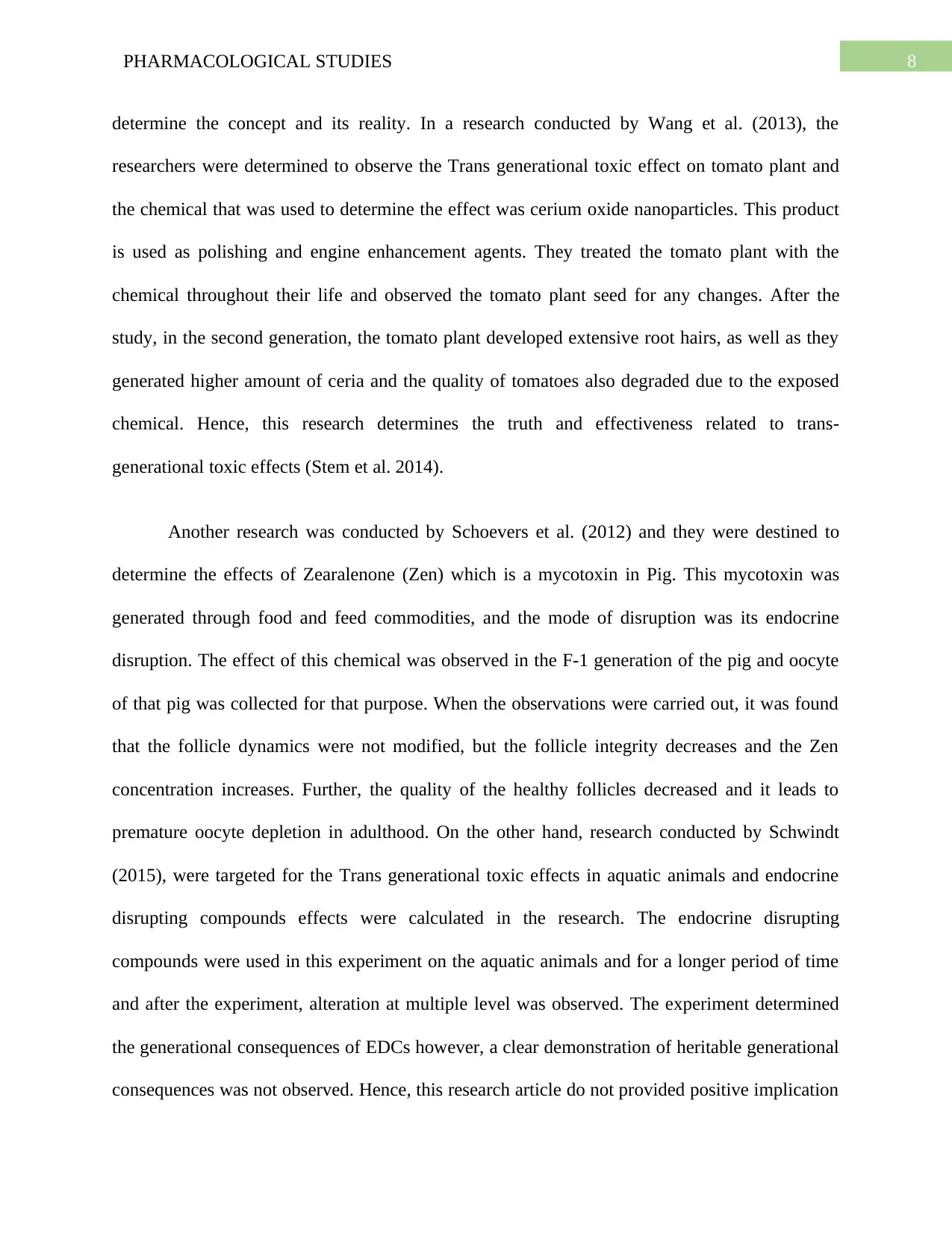
8PHARMACOLOGICAL STUDIES
determine the concept and its reality. In a research conducted by Wang et al. (2013), the
researchers were determined to observe the Trans generational toxic effect on tomato plant and
the chemical that was used to determine the effect was cerium oxide nanoparticles. This product
is used as polishing and engine enhancement agents. They treated the tomato plant with the
chemical throughout their life and observed the tomato plant seed for any changes. After the
study, in the second generation, the tomato plant developed extensive root hairs, as well as they
generated higher amount of ceria and the quality of tomatoes also degraded due to the exposed
chemical. Hence, this research determines the truth and effectiveness related to trans-
generational toxic effects (Stem et al. 2014).
Another research was conducted by Schoevers et al. (2012) and they were destined to
determine the effects of Zearalenone (Zen) which is a mycotoxin in Pig. This mycotoxin was
generated through food and feed commodities, and the mode of disruption was its endocrine
disruption. The effect of this chemical was observed in the F-1 generation of the pig and oocyte
of that pig was collected for that purpose. When the observations were carried out, it was found
that the follicle dynamics were not modified, but the follicle integrity decreases and the Zen
concentration increases. Further, the quality of the healthy follicles decreased and it leads to
premature oocyte depletion in adulthood. On the other hand, research conducted by Schwindt
(2015), were targeted for the Trans generational toxic effects in aquatic animals and endocrine
disrupting compounds effects were calculated in the research. The endocrine disrupting
compounds were used in this experiment on the aquatic animals and for a longer period of time
and after the experiment, alteration at multiple level was observed. The experiment determined
the generational consequences of EDCs however, a clear demonstration of heritable generational
consequences was not observed. Hence, this research article do not provided positive implication
determine the concept and its reality. In a research conducted by Wang et al. (2013), the
researchers were determined to observe the Trans generational toxic effect on tomato plant and
the chemical that was used to determine the effect was cerium oxide nanoparticles. This product
is used as polishing and engine enhancement agents. They treated the tomato plant with the
chemical throughout their life and observed the tomato plant seed for any changes. After the
study, in the second generation, the tomato plant developed extensive root hairs, as well as they
generated higher amount of ceria and the quality of tomatoes also degraded due to the exposed
chemical. Hence, this research determines the truth and effectiveness related to trans-
generational toxic effects (Stem et al. 2014).
Another research was conducted by Schoevers et al. (2012) and they were destined to
determine the effects of Zearalenone (Zen) which is a mycotoxin in Pig. This mycotoxin was
generated through food and feed commodities, and the mode of disruption was its endocrine
disruption. The effect of this chemical was observed in the F-1 generation of the pig and oocyte
of that pig was collected for that purpose. When the observations were carried out, it was found
that the follicle dynamics were not modified, but the follicle integrity decreases and the Zen
concentration increases. Further, the quality of the healthy follicles decreased and it leads to
premature oocyte depletion in adulthood. On the other hand, research conducted by Schwindt
(2015), were targeted for the Trans generational toxic effects in aquatic animals and endocrine
disrupting compounds effects were calculated in the research. The endocrine disrupting
compounds were used in this experiment on the aquatic animals and for a longer period of time
and after the experiment, alteration at multiple level was observed. The experiment determined
the generational consequences of EDCs however, a clear demonstration of heritable generational
consequences was not observed. Hence, this research article do not provided positive implication

9PHARMACOLOGICAL STUDIES
for trans generational toxic effects. However, depending on the other three research articles from
Wang et al. (2013) and Schoevers et al. (2012), trans generational toxic effect is an important
aspect and it occurs if the exposure to chemical is longer and effective.
for trans generational toxic effects. However, depending on the other three research articles from
Wang et al. (2013) and Schoevers et al. (2012), trans generational toxic effect is an important
aspect and it occurs if the exposure to chemical is longer and effective.
Secure Best Marks with AI Grader
Need help grading? Try our AI Grader for instant feedback on your assignments.
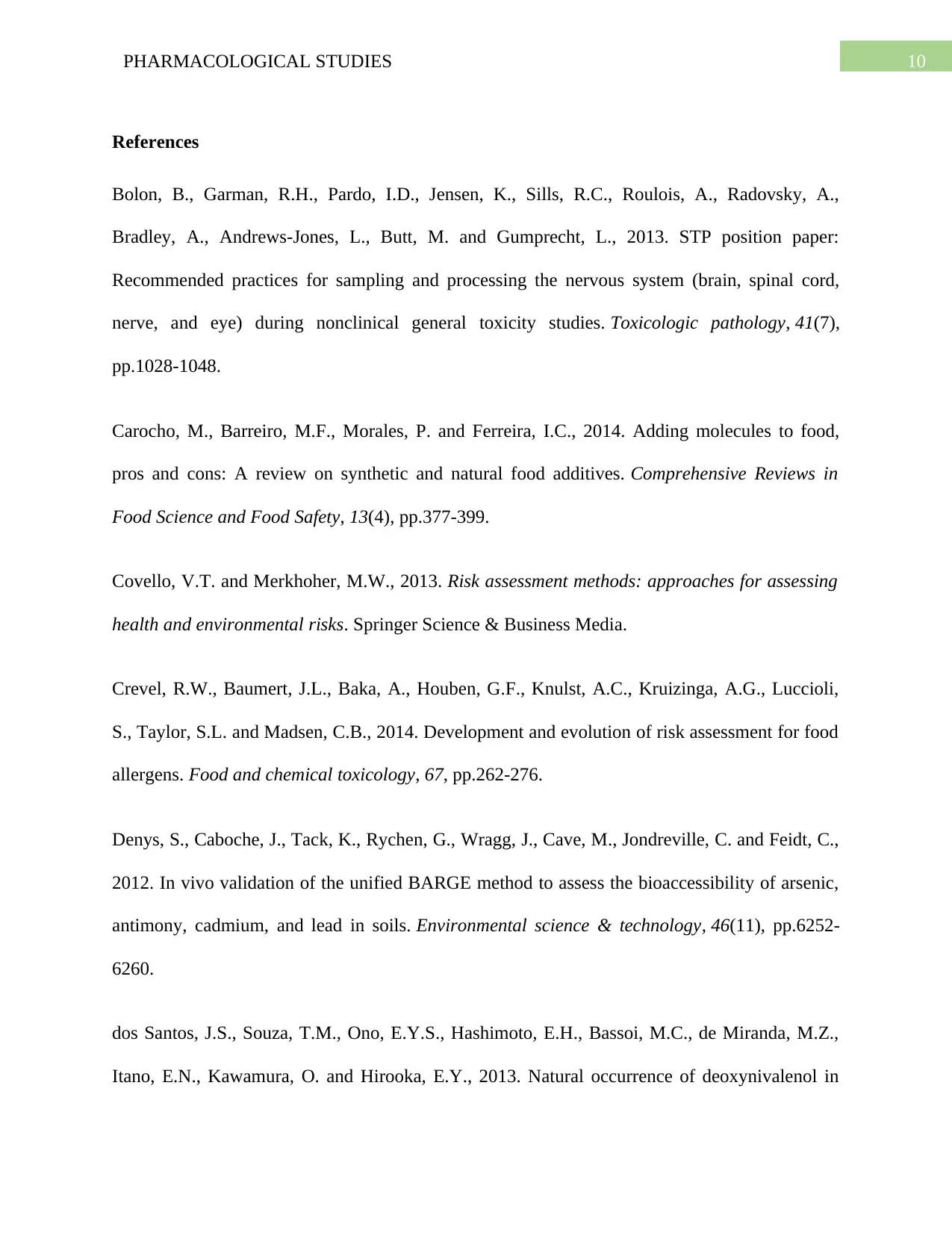
10PHARMACOLOGICAL STUDIES
References
Bolon, B., Garman, R.H., Pardo, I.D., Jensen, K., Sills, R.C., Roulois, A., Radovsky, A.,
Bradley, A., Andrews-Jones, L., Butt, M. and Gumprecht, L., 2013. STP position paper:
Recommended practices for sampling and processing the nervous system (brain, spinal cord,
nerve, and eye) during nonclinical general toxicity studies. Toxicologic pathology, 41(7),
pp.1028-1048.
Carocho, M., Barreiro, M.F., Morales, P. and Ferreira, I.C., 2014. Adding molecules to food,
pros and cons: A review on synthetic and natural food additives. Comprehensive Reviews in
Food Science and Food Safety, 13(4), pp.377-399.
Covello, V.T. and Merkhoher, M.W., 2013. Risk assessment methods: approaches for assessing
health and environmental risks. Springer Science & Business Media.
Crevel, R.W., Baumert, J.L., Baka, A., Houben, G.F., Knulst, A.C., Kruizinga, A.G., Luccioli,
S., Taylor, S.L. and Madsen, C.B., 2014. Development and evolution of risk assessment for food
allergens. Food and chemical toxicology, 67, pp.262-276.
Denys, S., Caboche, J., Tack, K., Rychen, G., Wragg, J., Cave, M., Jondreville, C. and Feidt, C.,
2012. In vivo validation of the unified BARGE method to assess the bioaccessibility of arsenic,
antimony, cadmium, and lead in soils. Environmental science & technology, 46(11), pp.6252-
6260.
dos Santos, J.S., Souza, T.M., Ono, E.Y.S., Hashimoto, E.H., Bassoi, M.C., de Miranda, M.Z.,
Itano, E.N., Kawamura, O. and Hirooka, E.Y., 2013. Natural occurrence of deoxynivalenol in
References
Bolon, B., Garman, R.H., Pardo, I.D., Jensen, K., Sills, R.C., Roulois, A., Radovsky, A.,
Bradley, A., Andrews-Jones, L., Butt, M. and Gumprecht, L., 2013. STP position paper:
Recommended practices for sampling and processing the nervous system (brain, spinal cord,
nerve, and eye) during nonclinical general toxicity studies. Toxicologic pathology, 41(7),
pp.1028-1048.
Carocho, M., Barreiro, M.F., Morales, P. and Ferreira, I.C., 2014. Adding molecules to food,
pros and cons: A review on synthetic and natural food additives. Comprehensive Reviews in
Food Science and Food Safety, 13(4), pp.377-399.
Covello, V.T. and Merkhoher, M.W., 2013. Risk assessment methods: approaches for assessing
health and environmental risks. Springer Science & Business Media.
Crevel, R.W., Baumert, J.L., Baka, A., Houben, G.F., Knulst, A.C., Kruizinga, A.G., Luccioli,
S., Taylor, S.L. and Madsen, C.B., 2014. Development and evolution of risk assessment for food
allergens. Food and chemical toxicology, 67, pp.262-276.
Denys, S., Caboche, J., Tack, K., Rychen, G., Wragg, J., Cave, M., Jondreville, C. and Feidt, C.,
2012. In vivo validation of the unified BARGE method to assess the bioaccessibility of arsenic,
antimony, cadmium, and lead in soils. Environmental science & technology, 46(11), pp.6252-
6260.
dos Santos, J.S., Souza, T.M., Ono, E.Y.S., Hashimoto, E.H., Bassoi, M.C., de Miranda, M.Z.,
Itano, E.N., Kawamura, O. and Hirooka, E.Y., 2013. Natural occurrence of deoxynivalenol in
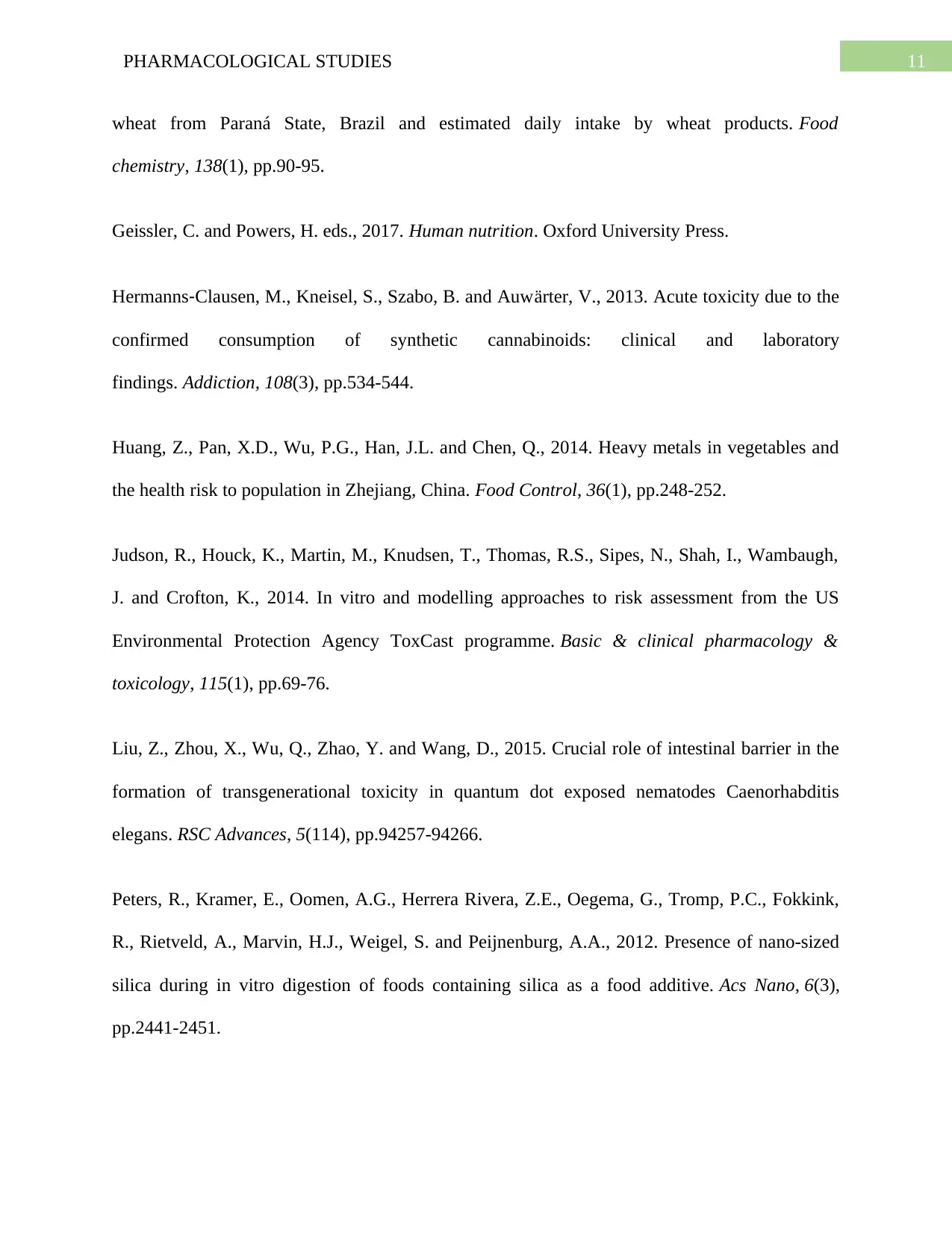
11PHARMACOLOGICAL STUDIES
wheat from Paraná State, Brazil and estimated daily intake by wheat products. Food
chemistry, 138(1), pp.90-95.
Geissler, C. and Powers, H. eds., 2017. Human nutrition. Oxford University Press.
Hermanns‐Clausen, M., Kneisel, S., Szabo, B. and Auwärter, V., 2013. Acute toxicity due to the
confirmed consumption of synthetic cannabinoids: clinical and laboratory
findings. Addiction, 108(3), pp.534-544.
Huang, Z., Pan, X.D., Wu, P.G., Han, J.L. and Chen, Q., 2014. Heavy metals in vegetables and
the health risk to population in Zhejiang, China. Food Control, 36(1), pp.248-252.
Judson, R., Houck, K., Martin, M., Knudsen, T., Thomas, R.S., Sipes, N., Shah, I., Wambaugh,
J. and Crofton, K., 2014. In vitro and modelling approaches to risk assessment from the US
Environmental Protection Agency ToxCast programme. Basic & clinical pharmacology &
toxicology, 115(1), pp.69-76.
Liu, Z., Zhou, X., Wu, Q., Zhao, Y. and Wang, D., 2015. Crucial role of intestinal barrier in the
formation of transgenerational toxicity in quantum dot exposed nematodes Caenorhabditis
elegans. RSC Advances, 5(114), pp.94257-94266.
Peters, R., Kramer, E., Oomen, A.G., Herrera Rivera, Z.E., Oegema, G., Tromp, P.C., Fokkink,
R., Rietveld, A., Marvin, H.J., Weigel, S. and Peijnenburg, A.A., 2012. Presence of nano-sized
silica during in vitro digestion of foods containing silica as a food additive. Acs Nano, 6(3),
pp.2441-2451.
wheat from Paraná State, Brazil and estimated daily intake by wheat products. Food
chemistry, 138(1), pp.90-95.
Geissler, C. and Powers, H. eds., 2017. Human nutrition. Oxford University Press.
Hermanns‐Clausen, M., Kneisel, S., Szabo, B. and Auwärter, V., 2013. Acute toxicity due to the
confirmed consumption of synthetic cannabinoids: clinical and laboratory
findings. Addiction, 108(3), pp.534-544.
Huang, Z., Pan, X.D., Wu, P.G., Han, J.L. and Chen, Q., 2014. Heavy metals in vegetables and
the health risk to population in Zhejiang, China. Food Control, 36(1), pp.248-252.
Judson, R., Houck, K., Martin, M., Knudsen, T., Thomas, R.S., Sipes, N., Shah, I., Wambaugh,
J. and Crofton, K., 2014. In vitro and modelling approaches to risk assessment from the US
Environmental Protection Agency ToxCast programme. Basic & clinical pharmacology &
toxicology, 115(1), pp.69-76.
Liu, Z., Zhou, X., Wu, Q., Zhao, Y. and Wang, D., 2015. Crucial role of intestinal barrier in the
formation of transgenerational toxicity in quantum dot exposed nematodes Caenorhabditis
elegans. RSC Advances, 5(114), pp.94257-94266.
Peters, R., Kramer, E., Oomen, A.G., Herrera Rivera, Z.E., Oegema, G., Tromp, P.C., Fokkink,
R., Rietveld, A., Marvin, H.J., Weigel, S. and Peijnenburg, A.A., 2012. Presence of nano-sized
silica during in vitro digestion of foods containing silica as a food additive. Acs Nano, 6(3),
pp.2441-2451.
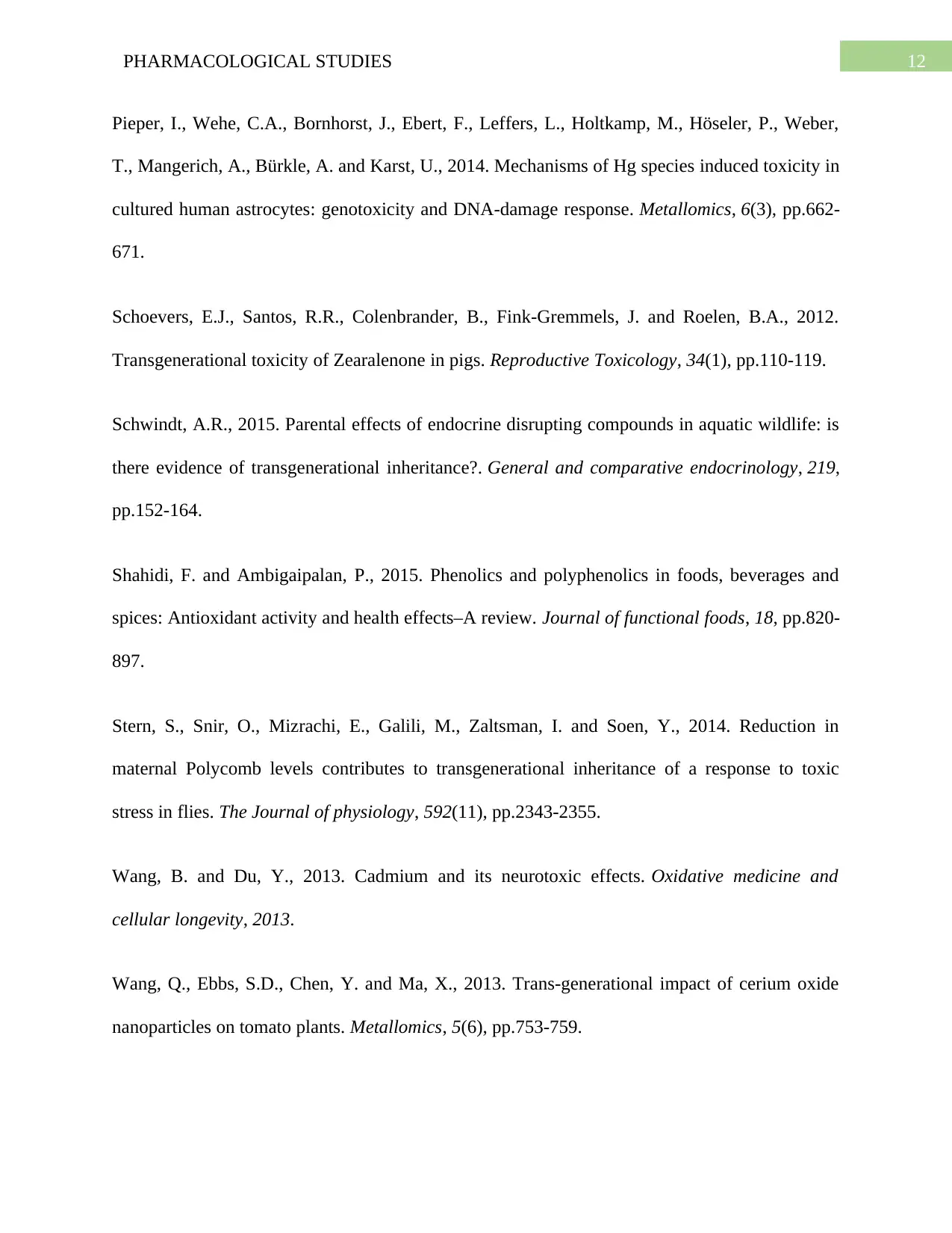
12PHARMACOLOGICAL STUDIES
Pieper, I., Wehe, C.A., Bornhorst, J., Ebert, F., Leffers, L., Holtkamp, M., Höseler, P., Weber,
T., Mangerich, A., Bürkle, A. and Karst, U., 2014. Mechanisms of Hg species induced toxicity in
cultured human astrocytes: genotoxicity and DNA-damage response. Metallomics, 6(3), pp.662-
671.
Schoevers, E.J., Santos, R.R., Colenbrander, B., Fink-Gremmels, J. and Roelen, B.A., 2012.
Transgenerational toxicity of Zearalenone in pigs. Reproductive Toxicology, 34(1), pp.110-119.
Schwindt, A.R., 2015. Parental effects of endocrine disrupting compounds in aquatic wildlife: is
there evidence of transgenerational inheritance?. General and comparative endocrinology, 219,
pp.152-164.
Shahidi, F. and Ambigaipalan, P., 2015. Phenolics and polyphenolics in foods, beverages and
spices: Antioxidant activity and health effects–A review. Journal of functional foods, 18, pp.820-
897.
Stern, S., Snir, O., Mizrachi, E., Galili, M., Zaltsman, I. and Soen, Y., 2014. Reduction in
maternal Polycomb levels contributes to transgenerational inheritance of a response to toxic
stress in flies. The Journal of physiology, 592(11), pp.2343-2355.
Wang, B. and Du, Y., 2013. Cadmium and its neurotoxic effects. Oxidative medicine and
cellular longevity, 2013.
Wang, Q., Ebbs, S.D., Chen, Y. and Ma, X., 2013. Trans-generational impact of cerium oxide
nanoparticles on tomato plants. Metallomics, 5(6), pp.753-759.
Pieper, I., Wehe, C.A., Bornhorst, J., Ebert, F., Leffers, L., Holtkamp, M., Höseler, P., Weber,
T., Mangerich, A., Bürkle, A. and Karst, U., 2014. Mechanisms of Hg species induced toxicity in
cultured human astrocytes: genotoxicity and DNA-damage response. Metallomics, 6(3), pp.662-
671.
Schoevers, E.J., Santos, R.R., Colenbrander, B., Fink-Gremmels, J. and Roelen, B.A., 2012.
Transgenerational toxicity of Zearalenone in pigs. Reproductive Toxicology, 34(1), pp.110-119.
Schwindt, A.R., 2015. Parental effects of endocrine disrupting compounds in aquatic wildlife: is
there evidence of transgenerational inheritance?. General and comparative endocrinology, 219,
pp.152-164.
Shahidi, F. and Ambigaipalan, P., 2015. Phenolics and polyphenolics in foods, beverages and
spices: Antioxidant activity and health effects–A review. Journal of functional foods, 18, pp.820-
897.
Stern, S., Snir, O., Mizrachi, E., Galili, M., Zaltsman, I. and Soen, Y., 2014. Reduction in
maternal Polycomb levels contributes to transgenerational inheritance of a response to toxic
stress in flies. The Journal of physiology, 592(11), pp.2343-2355.
Wang, B. and Du, Y., 2013. Cadmium and its neurotoxic effects. Oxidative medicine and
cellular longevity, 2013.
Wang, Q., Ebbs, S.D., Chen, Y. and Ma, X., 2013. Trans-generational impact of cerium oxide
nanoparticles on tomato plants. Metallomics, 5(6), pp.753-759.
Paraphrase This Document
Need a fresh take? Get an instant paraphrase of this document with our AI Paraphraser
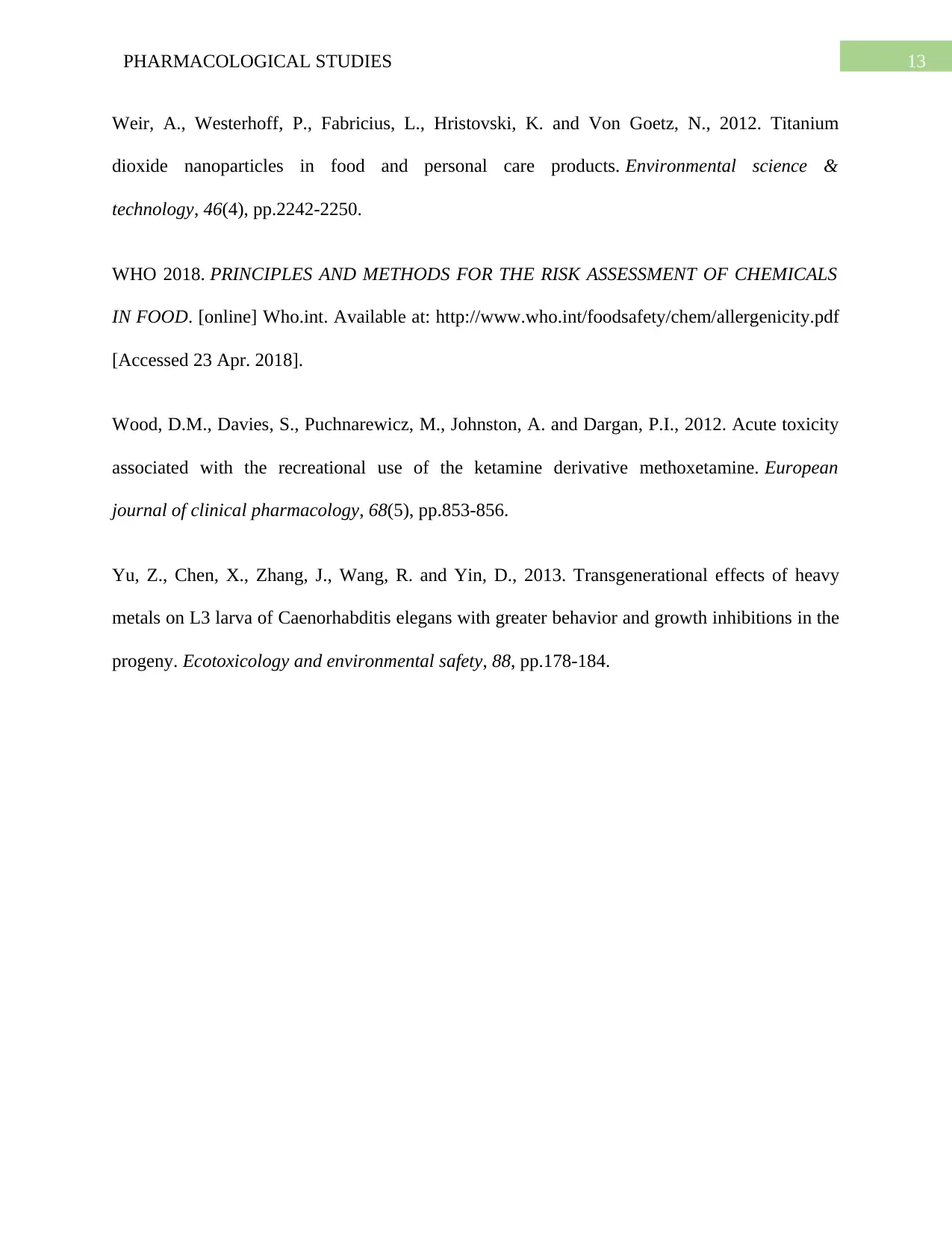
13PHARMACOLOGICAL STUDIES
Weir, A., Westerhoff, P., Fabricius, L., Hristovski, K. and Von Goetz, N., 2012. Titanium
dioxide nanoparticles in food and personal care products. Environmental science &
technology, 46(4), pp.2242-2250.
WHO 2018. PRINCIPLES AND METHODS FOR THE RISK ASSESSMENT OF CHEMICALS
IN FOOD. [online] Who.int. Available at: http://www.who.int/foodsafety/chem/allergenicity.pdf
[Accessed 23 Apr. 2018].
Wood, D.M., Davies, S., Puchnarewicz, M., Johnston, A. and Dargan, P.I., 2012. Acute toxicity
associated with the recreational use of the ketamine derivative methoxetamine. European
journal of clinical pharmacology, 68(5), pp.853-856.
Yu, Z., Chen, X., Zhang, J., Wang, R. and Yin, D., 2013. Transgenerational effects of heavy
metals on L3 larva of Caenorhabditis elegans with greater behavior and growth inhibitions in the
progeny. Ecotoxicology and environmental safety, 88, pp.178-184.
Weir, A., Westerhoff, P., Fabricius, L., Hristovski, K. and Von Goetz, N., 2012. Titanium
dioxide nanoparticles in food and personal care products. Environmental science &
technology, 46(4), pp.2242-2250.
WHO 2018. PRINCIPLES AND METHODS FOR THE RISK ASSESSMENT OF CHEMICALS
IN FOOD. [online] Who.int. Available at: http://www.who.int/foodsafety/chem/allergenicity.pdf
[Accessed 23 Apr. 2018].
Wood, D.M., Davies, S., Puchnarewicz, M., Johnston, A. and Dargan, P.I., 2012. Acute toxicity
associated with the recreational use of the ketamine derivative methoxetamine. European
journal of clinical pharmacology, 68(5), pp.853-856.
Yu, Z., Chen, X., Zhang, J., Wang, R. and Yin, D., 2013. Transgenerational effects of heavy
metals on L3 larva of Caenorhabditis elegans with greater behavior and growth inhibitions in the
progeny. Ecotoxicology and environmental safety, 88, pp.178-184.
1 out of 14
Related Documents
Your All-in-One AI-Powered Toolkit for Academic Success.
+13062052269
info@desklib.com
Available 24*7 on WhatsApp / Email
![[object Object]](/_next/static/media/star-bottom.7253800d.svg)
Unlock your academic potential
© 2024 | Zucol Services PVT LTD | All rights reserved.





